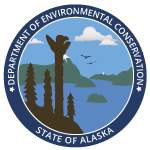Integrated Water Quality Monitoring and Assessment Report
Alaska's Integrated Report
Every two years, Alaska compiles and analyzes water quality data to determine if waterbodies are meeting Alaska Water Quality Standards. These waterbody assessments help DEC:
- Understand water quality in Alaska
- Prioritize restoration areas
- Protect human health
- Identify impairments and areas for restoration
- Prioritize grant funding to communities
Collectively this process is called the Integrated Water Quality Monitoring and Assessment Report, or Integrated Report. It satisfies Sections 305(b) and 303(d) of the Clean Water Act. Section 305(b) requires that the quality of all waterbodies be characterized, and Section 303(d) requires states list any waterbodies that do not meet water quality standards (these are known as polluted or impaired waters). The Integrated Report combines this information into a single comprehensive report.
Draft 2026 Integrated Report
The Alaska Department of Environmental Conservation (DEC) is currently preparing the 2026 Integrated Water Quality Monitoring and Assessment Report. The draft report is expected to be available for public comment by spring of 2026.
Approved 2024 IR
The 2024 Integrated Water Quality Monitoring and Assessment Report, including the 305(b) report on the status of State waters and the 303(d) Impaired Waters List was completed and approved on February 6, 2025. Assessment of water quality data concluded that two streams previously polluted near Fairbanks and Anchorage were found to be clean, two Anchorage streams already polluted for fecal coliform were found to also be polluted with E. Coli, and two polluted waters adjacent to the Red Devil Mine were approved for a cleanup plan. For a more detailed summary of the report, see the 2024 Integrated Report Factsheet.
- 2024 Integrated Report Factsheet
- EPA Letter of Approval
- 2024 Assessed Waters Map shows waterbodies assessed up to and including the 2024 Integrated Report.
- EPA's How's My Waterway is a publicly available mapper that shows the current status of waterbodies in Alaska.
- The ATTAINS Expert Query supports querying and downloading Integrated Report assessment results in an excel format.
Historically DEC prepared a paper Integrated Report to satisfy the reporting requirements of the Clean Water Act. There is no longer a paper report, instead water quality assessment information is managed in a system called ATTAINS (Assessment and Total Maximum Daily Load Tracking and Implementation System).
Past IRs/Resources
Approved Integrated Reports
- 2022 Integrated Report
- 2020 Integrated Report
- 2018 Integrated Report
- 2014/2016 Integrated Report
- 2012 Integrated Report
- 2010 Integrated Report
- 2008 Integrated Report
- 2006 Integrated Report
- 2004 Integrated Report
- 2002-3 Integrated Report
- 1998 Integrated Report
- 1996 Integrated Report
Final Listing Methodology
- Alaska Consolidated Assessment and Listing Methodology (PDF)
- Turbidity (PDF)
- Petroleum Hydrocarbons, Oils and Grease (PDF)
- Pathogens 2021 (PDF)
- Residues (PDF)
Water Quality Data
This map depicts waters assessed up to and including the 2024 Final Integrated Report. There are 5 categories to which a waterbody can be assigned when assessed, based on whether or not water quality standards are being met. Categories 1 and 2 are meeting standards for some or all of their designated uses, category 3 includes waters for which there is not enough information to make a determination, and categories 4 and 5 include waters that are not meeting standards for some designated uses. Waterbodies shown on the map have been evaluated, zoom in to see the assessed portion of an individual waterbody.
Waters that persistently do not meet Alaska’s Water Quality Standards (18 AAC 70) are placed in Alaska’s 303(d) Category 5 Impaired Waters List through the Integrated Reporting process. When a water is Category 5 listed, it triggers certain requirements in order for that water to move out of Category 5.
A Total Maximum Daily Load (TMDL) establishes the maximum amount of a pollutant allowed in a waterbody and serves as the starting point or planning tool for restoring water quality. A TMDL identifies pollution sources in a waterbody and calculates the amount or 'load' of that specific pollutant that the water can receive and still maintain Water Quality Standards. TMDLs are a necessary first step toward waterbody recovery and are the primary tool per the Clean Water Act for a waterbody to be moved from the Alaska 303(d) Category 5 Impaired Waters List. TMDLs are approved by EPA and once approved, the water-body moves to Category 4a, impaired with a recovery plan in place. TMDL implementation includes taking actions to improve water quality. See TMDL FAQs for more information
TMDLs are not the only tool DEC utilizes for planning water quality improvements in impaired waters. EPA allows alternative plans that identify actions that when implemented are expected to improve water quality in a set amount of time. These types of alternative plans are also approved by EPA and move an impaired water from Category 5 to Category 4b, impaired with an alternative recovery plan in place. DEC developed a 10-year Prioritization Framework as part of the 303(d) program and EPA’s Vision process. The document outlines the approach and considerations DEC uses for restoring and protecting water quality.


 Indicates an external site.
Indicates an external site.